
Author: Phil Wain/Classic Racer
A 500cc Grand Prix winner at the age of 23, John ‘Noddy’ Newbold was a formidable opponent during the 1970s and 80s, winning an International road race and countless British Championship races as both a privateer and works Suzuki rider. Phil Wain charts a career cut short.
John Newbold, who also carried the nickname ‘Joe 90’, was born in Jacksdale, Nottinghamshire, like fellow racer Steve Henshaw, on December 14 1952, but he was raised in South Normanton where his parents ran a butcher’s shop.
Related articles:
- The story behind the name Sunbeam
- Barry Sheene: Life and career in pictures
- Beautiful 650cc Triumph Bonneville does not disappoint
He got the racing bug riding on the grass when a teenager and, after graduating through the Dixon Racing School, switched to the tarmac as soon as he could, having his first race at Darley Moor in April 1971.
Having started out on a 250cc Royal Enfield, for the next two years he contested club meetings on a 350cc Yamsel loaned to him by John Cooper, finishing second in the 1973 Grovewood Awards.

However, it was when dad Maurice and a syndicate he was part of had a sizeable win of £130,000 on the football pools that allowed him to buy a pair of Yamahas and move up to the National events.
For 1975, and having only just turned 22, John got what every racer dreams of – a factory ride and the opportunity to contest the World Championship. His results of 1974, which saw him take second in the ACU British Championship and seventh in the 350cc Dutch GP, hadn’t gone unnoticed and he was duly signed up by Heron Suzuki to contest the 500cc and 750c World Championships where he would be team-mate to another youngster by the name of Barry Sheene.
In at the deep end
It was, perhaps understandably, a slow start to the season and some began to wonder why Suzuki had signed him but he soon began to prove his worth on the 500cc Suzuki-4 and impressive performances began to materialise.
Seventh in the Italian GP gave him his first World Championship points and this was soon followed by fourth at Assen, Holland. His best result of the year came a week later at Spa, Belgium, when he finished second behind Phil Read’s MV Agusta to show what a formidable combination John and the Suzuki had now become.
Fifth overall was also taken in the FIM 750cc Championship, third being his best finish in Assen, and John took his first win for Suzuki at the end of season Brands Hatch meeting. With a more than solid first season as a works rider under his belt, John’s services were duly retained for 1976 where he lined up alongside Sheene and John Williams for a similar campaign.
The season started poorly though and he failed to score points in any of the first five rounds of the 500cc World Championship. And when he did finish in the top ten, at Belgium and Sweden, it was lowly ninth and tenth places.
However, fourth in Finland was the start of a strong second half to the season.
With Sheene having clinched the Championship two rounds earlier in Sweden, he opted out of the following Finnish, Czechoslovakian and German rounds held on the public road circuits of Imatra, Brno and Nurburgring but John decided to continue his season and it proved to be one of the best decisions he ever made as he went on to have his three best ever Grand Prix results, the race at Brno being a highlight of his career.
He ended up winning comfortably, by over 11 seconds, from pole man Tepi Lansivouri and Philippe Coulon and he followed that up with another fourth, at Hockenheim, which enabled him to secure fifth overall in the title table, no mean feat indeed.
The 750cc World Championship was even more profitable with no less than four fourth place finishes being attained to give him an excellent third place overall. However, despite those results and having claimed his first Grand Prix win, John’s contract with Heron Suzuki wasn’t renewed and his spell with the team ended after two years, being replaced by rising youngsters Pat Hennen and Steve Parrish, so it was back to privateer status for 1977.
Privateer again
It was Lincolnshire motorcycle dealer Ray Hamblin who eventually secured the services of the still only 24-year-old Newbold for the new season and provided him with a TZ750 Yamaha and RG500 for a concerted attack on the domestic scene, primarily the MCN Superbike and Shellsport 500cc Championships as well as a first appearance at the International North West 200.

It proved to be a mixed year back among the privateer ranks but while the 750cc was blighted by mechanical problems, the 500cc was more profitable and he ended the season in fifth overall in the Shellsport 500cc Championship, second place at Mallory Park in June his best finish.
The undoubted highlight came, surprisingly, on the roads. Up until 1977, John had steered clear of the likes of the North West 200, Isle of Man TT and Ulster Grand Prix but that year saw him, along with Ron Haslam and Dave Potter, make his debut at the NW200.
He was a first lap retirement in the 500cc race but saved the best until last with a stunning ride in the feature Superbike race. Mick Grant was the early leader before fuel from the rear breather got on to his back tyre and forced him to stop and that allowed John Williams to take the victory.
However, Newbold amazingly pushed the absolute lap record to 123.81mph and then overhauled Steve Parrish to take second on the final lap going quicker still at 124.06mph.
The partnership between John and Hamblin continued for the 1978 season and it would be a year that gave him one of his finest ever moments – an International road race win at the North West 200.
Having broken the lap record (again!) in practice, hopes were high going into his races but the opening Superbike race brought disappointment as he toured into the pits to retire at the end of the first lap. However, the 500cc race went perfectly and he successfully staved off the close attentions of fellow RG500 Suzuki rider George Fogarty to claim a brilliant win.

Brushing the Armco at Mallory Park, Easter 1975, TR750 mounted.
In the feature NW200 Superbike race, Tom Herron and Tony Rutter fought out the win, before the former’s tyres went off, and John found himself locked in battle with Haslam, Kevin Stowe and Charlie Williams for the final two podium spots. It was Stowe who sealed second place but John completed his day with a fine third on the big TZ750 Yamaha.
He had intended to contest a full season in the 500cc World Championship but, for a variety of reasons, he quit the series half way through the year to concentrate on the home meetings.
The primary gear for the main drive broke in Spain and then in Austria the engine seized midway through the race. He raced at the Dutch and Belgian rounds due to his liking of the circuits, taking seventh at Assen, but his only other GP was his home round at Silverstone where he took eighth.
It was a wise decision and after an unhappy early part of 1978, the domestic scene was a lot better with his battle with Barry Sheene at the August Bank Holiday Oulton Park meeting a highlight.
Second to Wil Hartog at Cadwell was also pleasing along with second to Dennis Ireland at Snetterton in July and third to the Kawasaki works riders Kork Ballington and Mick Grant in the 350cc race at Donington in September.
Indeed, he ended the year in second overall, only beaten by Sheene, in the Shellsport 500cc Championship but, after two years with Hamblin, John moved camp for 1979 after a chance meeting at Mallory Park with Dave Orton from Appleby Glade.
Orton was unsure whether or not to carry on after the loss of his rider John Williams at the ’78 Ulster GP but he decided to back Newbold with the 500cc Shellsport and MCN Superbike Championships were the priority.
The year started well with an excellent win at Mallory Park in the Transatlantic Trophy Match Races but, overall, it would prove to be a hugely disappointing season as a heavy spill at Oulton Park left him with a broken leg and spelt the end of his season as the break was plated but not before he’d performed superbly on his Ulster Grand Prix debut though.
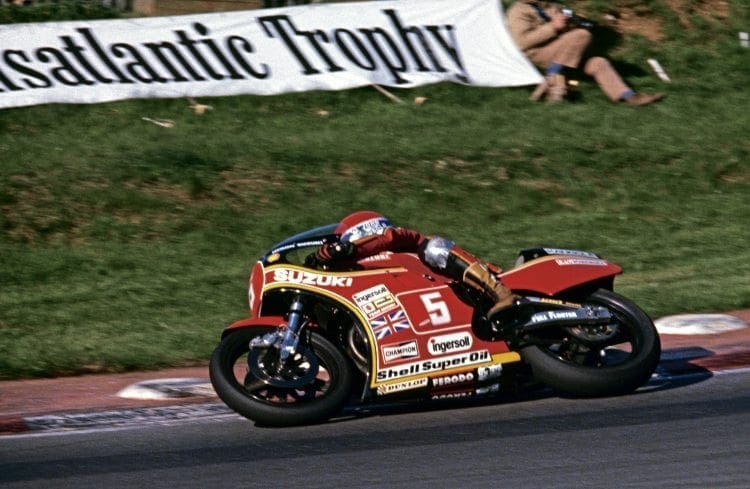
Two great shots from Brands Hatch in 1981. Above: the big four-stroke F1 Suzuki and below aboard the Suzuki RG500.
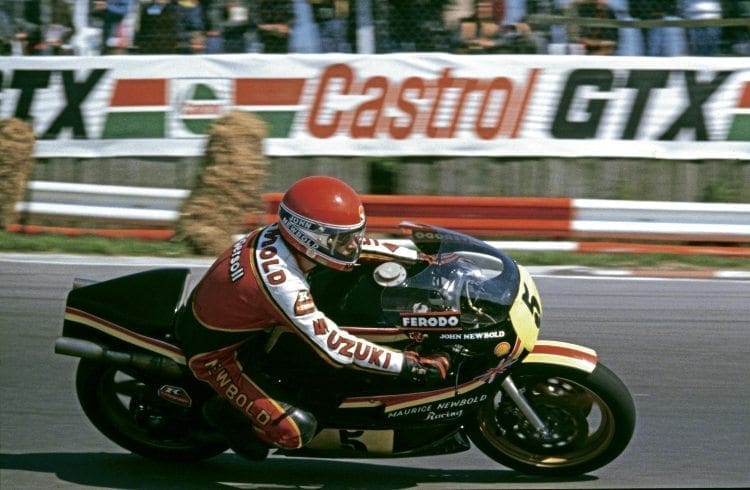
Despite poor weather in practice, and a close call when Joey Dunlop was blinded by spray and collided with the rear of his machine, John was immediately disputing the lead in the 500cc race with Dennis Ireland, Tony Rutter and John Woodley. Dunlop ultimately caught and passed all of them to take a win but John claimed an excellent second place.
Dunlop repeated his victory in the 1000cc race, just getting the better of Roger Marshall, but John was again on the podium in third after Steve Cull slipped back to sixth on the final lap.
Back to fitness
John was back to full fitness for 1980 where he lined up, once more, in the colours of Appleby Glade, armed again with a TZ750 Yamaha. Team boss Orton also purchased a new 997cc Harris-framed Suzuki mid-way through the season so that John could contest the British F1 Championship as well as the Ulster Grand Prix.
Part of the British Transatlantic team once more, John was the second highest points scorer for the home team after six highly consistent finishes but the American visitors romped home comfortable victors.
On to the North West 200 and the 500cc race was a nail-biting affair with Mick Grant leading from Stu Avant, John, Ireland and Parrish at the end of lap one. John then took over the lead until lap four before Dunlop led briefly until he ground to a halt with gearbox failure. John was then denied his second North West 200 win when he had to retire with a sticking throttle.
He did go the distance in the feature Superbike race though and what a race it proved to be as John fought tooth and nail with Keith Huewen for the entire race distance.
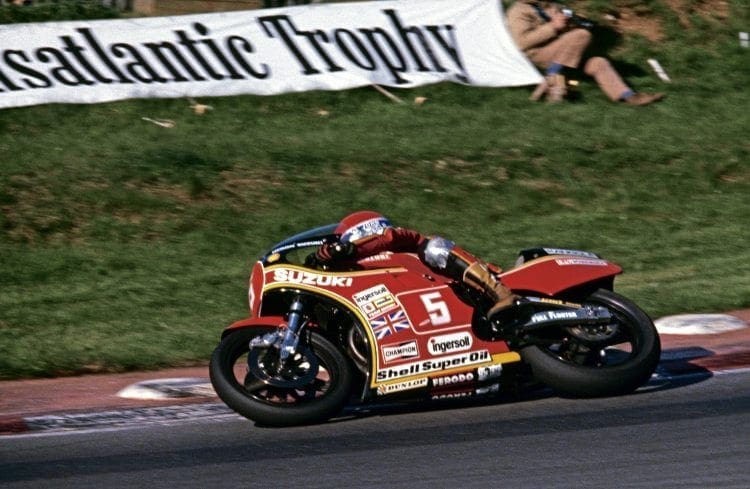
Brands Hatch 1981 Match Races, this time leading USA teamster, Dale Singleton.
The duo exchanged the lead on each and every lap with the pairing even finding the time to pinch each other’s backsides along the high speed straights! As it was, Huewen set a new lap record on the final lap to edge out John by the width of a tyre.
Another International road racing podium, third, was taken in the 1000cc Classic race. Having led for the first four laps, he was eventually overhauled by Dunlop and Marshall and he would have finished in the top four of the World Formula One Championship race had he not been plagued by a misting visor that dropped him back to eleventh.
On the home front, solid rides saw him finish tenth overall in both the MCN/Duckhams Superbike and 500cc Shellsport Championships.
He only competed in four rounds of the British Formula One Championship but three top four finishes enabled him to take eighth in the final Championship table. National race wins were also taken at Cadwell and Mallory.
After strong showings throughout 1980, in both the 500cc and F1 British Championships, Newbold was delighted to get the call from Suzuki GB to ride for them once more in 1981, five years after they parted company.
Newbold would contest the World and F1 British Championships for Rex White’s team, joining Graeme Crosby and Mick Grant in a three-pronged attack and it meant he would make a much anticipated debut at the Isle of Man TT while he’d also continue in the 500cc class on a Shell Oils-backed RG500.
The year couldn’t have started better for John as a series of highly consistent performances over the Easter weekend resulted in him not only being the top British points scorer in the Transatlantic Trophy but the top points scorer overall and ahead of the likes of Randy Mamola and Freddie Spencer as the British team finally got back to winning ways.
He was immediately repaying the faith shown in him by White and Suzuki GB and his first outing on the roads, the North West 200, saw him continue with his good form although he was ultimately out of luck in the races.
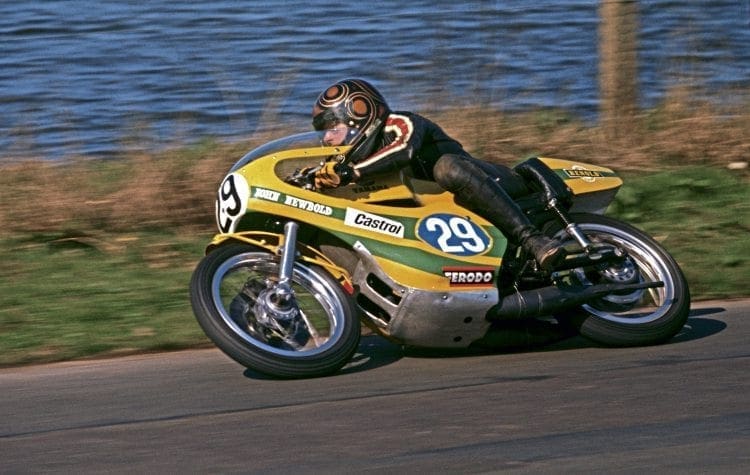
John Newbold, on his way to getting noticed by the top teams on his TZ350.
He was sidelined from the Superbike race with mechanical trouble but it looked like his day would end on a high as he opened up a four-second lead in the 500cc race.
Fate again dealt him an unlucky hand though as a gearbox bearing broke at half race distance although he did have the consolation of setting the fastest lap of the race, 119.87mph.
TT sensation
Despite not having the results to show for his efforts, John’s pace and form was as good as it had ever been and it set him up nicely for the TT.
He’d go on to make one of the finest debuts ever witnessed around the Mountain Course, a statement that still rings true today as his results were simply sensational.
From three starts, two on the 997cc Suzuki and one on the RG500, he took a stunning third place in the Senior, behind team-mate Grant and Donny Robinson, and backed this up with equally brilliant fourth place finishes in the World F1 and Classic races, only defeated by TT stars Graeme Crosby, Grant, Alex George, Ron Haslam and Joey Dunlop. Just for good measure, he also lapped in excess of 110mph to make him, at the time, the second fastest newcomer ever.
Back to the mainland and joint second overall in the British F1 Championship was the outcome, a win being taken at the final round at Brands along with podiums at Oulton and Mallory. He was also fourth overall in the Shellsport 500cc Championship.
Interspersed with the domestic campaign was another trip to Northern Ireland, for his now regular trip to the Ulster Grand Prix. Fourth place was taken in the World F1 race, to give him the same place in the overall Championship table, as he duly showed what a team player he was, shadowing Crosby and Grant home which helped the Kiwi take his second successive World title.
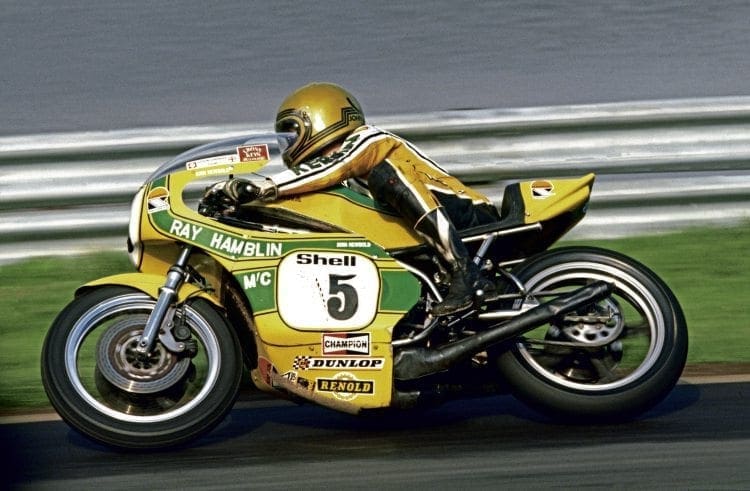
John in action for two sponsors prepared to put real money into the sport, above, Ray Hamblin, and below, Dave Orton of Appleby Glade.
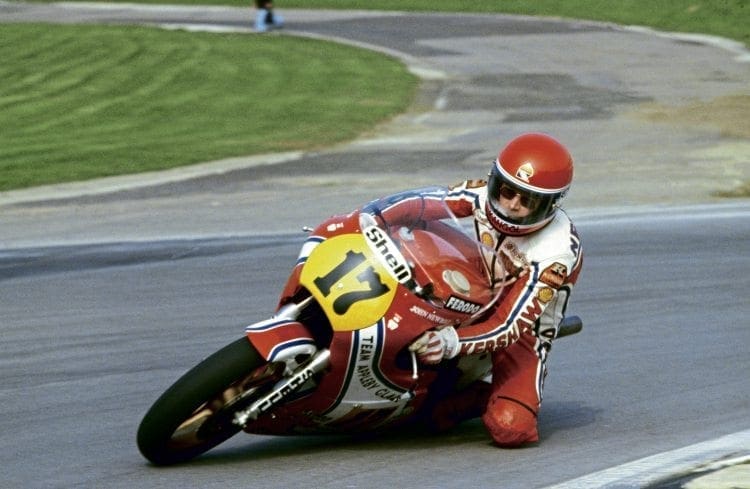
The shackles were off in the other races and despite the deteriorating conditions, John showed his aptitude in any weather as he took a good second place behind Gary Lingham in the 500cc race and third – for the third year in a row – on the big Suzuki in the feature Superbike race as Haslam and Grant came home first and second respectively.
It was very much a case of ‘as you were’ for the now 29-year-old in 1982, the only change being that Crosby left the team, to go full time Grand Prix racing with Marlboro Yamaha Agostini, and was replaced by one of John’s regular sparring partners, Roger Marshall.
Life cut short
As per previous years, John was again selected to be part of the Great Britain team for the Transatlantic Trophy and while he didn’t replicate the feats of 1981, he was nevertheless an integral part of the British success.
With 73 points, which included three podiums on the big Suzuki, he was the fourth highest British scorer behind Sheene, Marshall and Graham Wood.
After the early season British Championship meetings it was on to the North West 200 once more with the 1982 event taking place on May 15.
The opening Superbike race was, for the first time, also a round of the MCN Superbike Championship with the first lap seeing a front group of Newbold, Marshall, Haslam, Dunlop, Wayne Gardner, Grant and Wood open up a gap over the rest of the field, the expected Honda versus Suzuki battle immediately taking shape with the Fowlers of Bristol Yamaha of circuit newcomer Wood also well in contention.
The front group were running nose to tail and it was the closeness of the battle that ultimately spelt disaster when, at the end of the second lap, John touched the back of team-mate Grant at Juniper Hill, his front wheel touching Grant’s rear wheel.
High-sided from the machine at 130mph, John struck first the kerb and then a small wall, being killed instantly with the crash happening about 100 yards from the point where Tom Herron, another Heron Suzuki rider, had lost his life three years before.
Haslam (Honda) won the race from Marshall although the pair withdrew from the remainder of the meeting as soon as they heard the tragic news of their good friend. Grant opted to contest the final Superbike race and duly won it, dedicating the win to his team-mate.
John’s accident was the fifth fatality at the NW200 in the space of four years and, as a result, the course was changed in time for the following year’s meeting, with a chicane introduced in front of the Juniper Hill caravan park in order to reduce the speed of the machines around the final corner.
Like Dave Potter’s untimely passing the year before, John’s death was felt all across the sport as all who knew him described him as a gentle and thoughtful man who always had time for fellow racers and fans. His skill and determination made him one of the UK’s best riders and his wit and humour made him extremely popular. It was another cruel loss to the British racing fraternity.


